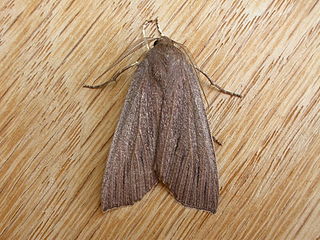Related Research Articles

Conogethes is a genus of moths in the subfamily Spilomelinae of the family Crambidae. The currently 17 recognized species are distributed in the Indomalayan and Australasian realm.

Palleopa is a monotypic moth genus in the family Geometridae. Its only species, Palleopa innotata, the finely-streaked crest-moth, is known from Australia, including Tasmania. Both the genus and species were first described by Francis Walker in 1866.
Curena externalis is a species of snout moth in the genus Curena. It was described by Francis Walker in 1866. It is found in the Australian states of New South Wales and Queensland.

Hypena gonospilalis is a species of moth of the family Erebidae first described by Francis Walker in 1866. It is found across the South Pacific, including the Cook Islands, Japan and Taiwan as well as the Australian state of Queensland.
Lambula pristina is a moth of the family Erebidae. It was described by Francis Walker in 1866. It is found in Australia.

Elophila responsalis is a moth in the family Crambidae. It was described by Francis Walker in 1866. It is found in Australia, where it has been recorded from Queensland.
Strepsicrates semicanella is a species of moth of the family Tortricidae first described by Francis Walker in 1866. It is found in south-east Asia and in New Caledonia, Australia and Japan. The habitat consists of alluvial forests.
Culladia hastiferalis is a moth in the family Crambidae. It was described by Francis Walker in 1866. It is found on Borneo, Sumatra, Java, Sulawesi, the Moluccas, New Guinea, Taiwan, the Philippines (Luzon) and Australia, where it has been recorded from Northern Territory and Queensland.

Chalcidoptera emissalis is a moth in the family Crambidae. It was described by Francis Walker in 1866. It is found in north-eastern India, Sri Lanka, Burma, Singapore, Borneo, Ambon Island, Aru, New Guinea and Australia, where it has been recorded from Queensland.
Conogethes diminutiva is a moth in the family Crambidae. It was described by William Warren in 1896. It is found in India and Australia.
Conogethes ersealis is a moth in the family Crambidae. It was described by Francis Walker in 1859. It is found in Australia, where it has been recorded from Queensland.
Conogethes pluto is a moth in the family Crambidae. It was described by Arthur Gardiner Butler in 1887. It is found on the Solomon Islands and in Burma, Thailand and Australia. The habitat consists of dry sclerophyll forests and wet lowland tropical rainforests.
Cydalima diaphanalis is a moth in the family Crambidae. It was described by Francis Walker in 1866. It is found in Burma, Indonesia, on the Solomon Islands and in Thailand and Australia, where it has been recorded from Queensland and South Australia.
Nausinoe globulipedalis is a moth in the family Crambidae. It was described by Francis Walker in 1866. It is found in Indonesia (Sulawesi), New Guinea and Australia, where it has been recorded from Queensland.
Nosophora hypsalis is a moth in the family Crambidae. It was described by Francis Walker in 1866. It is found in the Aru Islands of Indonesia and Australia, where it has been recorded from Queensland.
Omiodes dispilotalis is a moth in the family Crambidae. It was described by Francis Walker in 1866. It is found in Indonesia and Australia, where it has been recorded from Queensland.
Omiodes surrectalis is a moth in the family Crambidae. Described by Francis Walker in 1866, it is found in the Democratic Republic of the Congo, India, Indonesia, the Philippines, Sri Lanka, New Guinea and Queensland, Australia.
Pygospila bivittalis is a moth in the family Crambidae. It was described by Francis Walker in 1866. It is found in India, China, Indonesia, New Guinea and Australia, where it has been recorded from Queensland.
Tatobotys biannulalis is a moth in the family Crambidae. It was described by Francis Walker in 1866. It is found on Borneo and in Indonesia, the New Hebrides, Fiji, Samoa, Japan, Sri Lanka and Australia, where it has been recorded from the Northern Territory and Queensland.
References
- ↑ Nuss, M.; et al. (2003–2014). "GlobIZ search". Global Information System on Pyraloidea. Retrieved 2014-07-15.
- ↑ Savela, Markku. "Conogethes semifascialis (Walker, [1866])". Lepidoptera and Some Other Life Forms. Retrieved January 24, 2018.
- ↑ Lepidoptera Larvae of Australia
| This Margaroniini-related article is a stub. You can help Wikipedia by expanding it. |